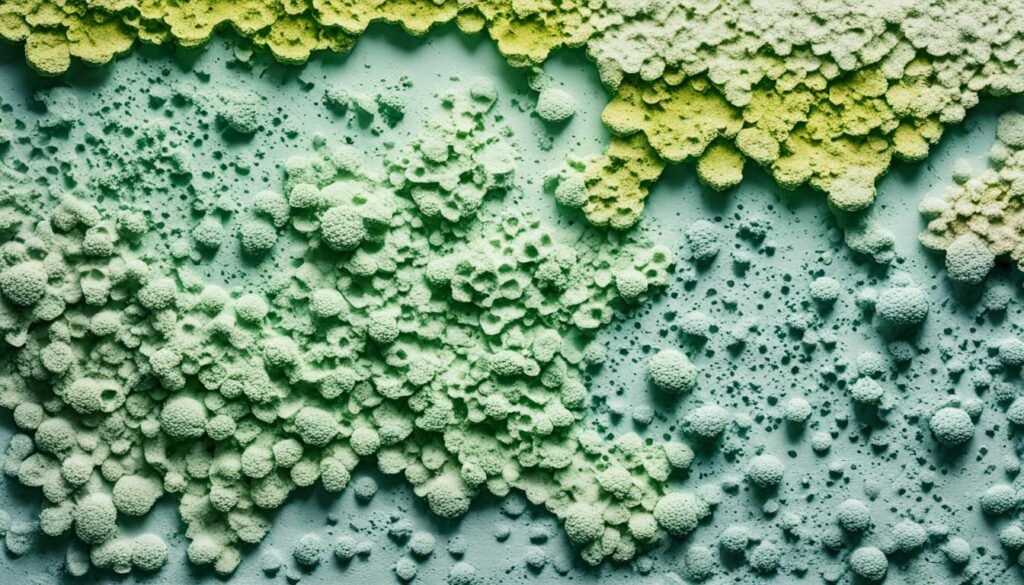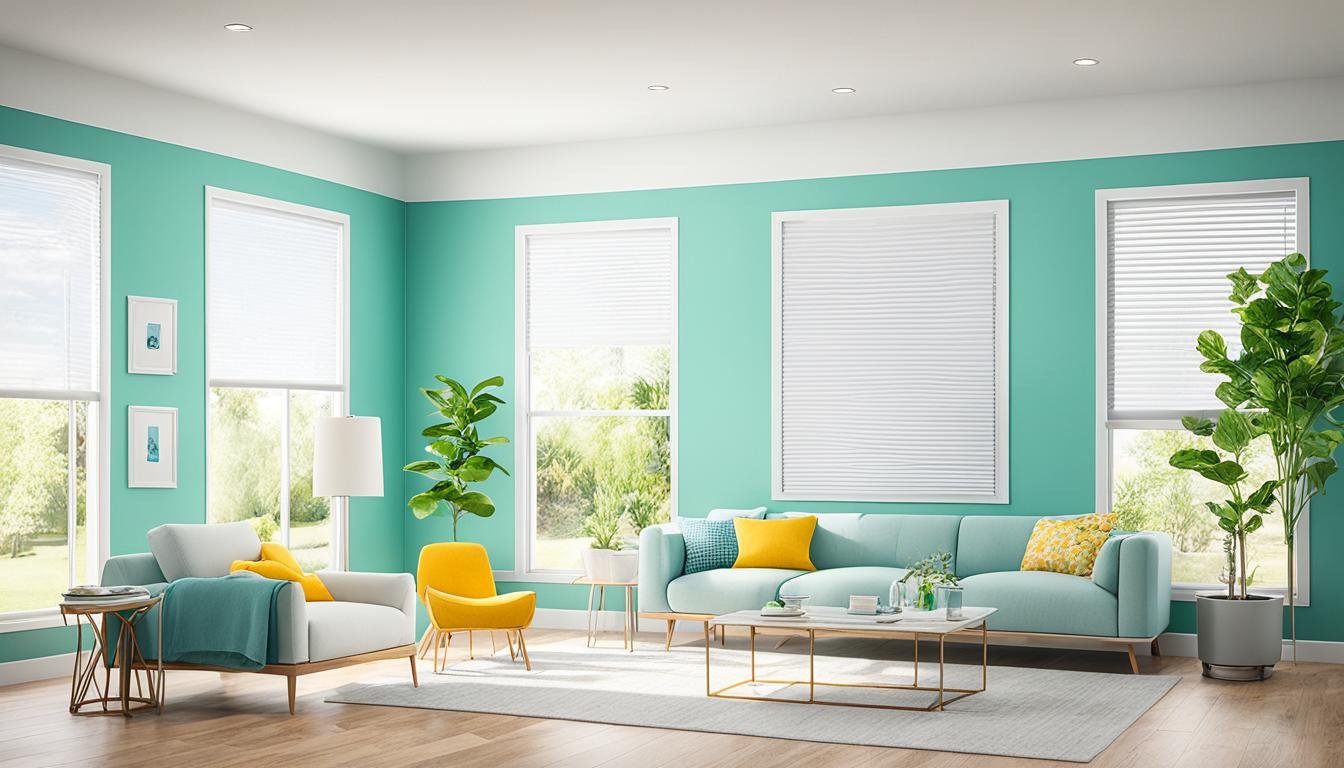When it comes to mold, it’s important to recognize that it can come in various colors, including black, green, gray, brown, purple, white, orange, yellow, pink, and red. However, the color of mold does not indicate its type, severity, or health risks. The color of mold can be influenced by factors such as age, humidity, food source, and light exposure.
Mildew, unlike mold, grows on surfaces without penetrating them, making it easier to clean. Mold, on the other hand, can penetrate materials and may require the removal of porous materials like carpet and drywall.
One of the most common types of mold is black mold, specifically Stachybotrys chartarum. This type of mold is often found in damp environments and can be particularly dangerous due to the production of neurotoxic compounds. It can cause respiratory symptoms and neurological effects, especially in children and immunocompromised individuals. The appearance of black mold can vary, but it is typically dark in color and has a slimy or powdery texture. It is known to cause structural damage to materials with high cellulose content.
Mold prevention in Riverside County involves implementing various techniques, utilizing experts, and employing suitable products and measures. By understanding the different types of mold and taking proactive steps to prevent its growth, you can create a healthier and safer environment for you and your family.
Key Takeaways:
- Mold comes in various colors, but color does not indicate type or severity.
- Mildew grows on surfaces without penetrating, while mold can penetrate materials.
- Black mold, like Stachybotrys chartarum, is particularly dangerous.
- Mold prevention in Riverside County involves techniques, experts, and products.
- By understanding mold types and taking preventive measures, you can create a healthier environment.
Common Types of Mold and their Characteristics
In homes and buildings, there are several common types of molds, each with its distinct characteristics. Here are some notable molds and their features:
Alternaria
Alternaria is a green mold that thrives in damp areas and organic debris. It can commonly be found in bathrooms, kitchens, and basements. While it is primarily an outdoor mold, it can easily find its way indoors, especially in humid environments.
Penicillium
Penicillium, known for its role in the production of penicillin, can appear white or black. It often grows in insulation, carpets, and water-damaged furniture. This mold can release spores into the air, leading to respiratory issues for those with allergies or weakened immune systems.
Aspergillus
Aspergillus is a widespread type of mold that can cause minor health complications. It thrives in warm, damp conditions and can contaminate food, air conditioning systems, and carpets. Certain species of Aspergillus can also produce airborne contaminants known as mycotoxins, which can pose additional health risks.
Cladosporium
Cladosporium is a resilient mold that can be found in various areas, including carpets, textiles, and wooden surfaces. It has a suede-like texture and appears as dark green or black spots. Cladosporium is known to cause allergies and respiratory issues in sensitive individuals.
Acremonium
Acremonium is often white or grey in color and can be dangerous to human health. It typically grows in areas with high moisture levels, such as cooling coils, humidifiers, and condensation pans. Exposure to Acremonium can lead to respiratory issues and other health complications, especially for individuals with weakened immune systems.
Stachybotrys
Commonly known as black mold, Stachybotrys develops on cellulose materials like wood, paper, and drywall. It appears black or dark green and has a slimy or powdery texture. This mold is especially concerning as it can produce mycotoxins that can cause severe respiratory issues, neurological effects, and even structural damage to the building materials.
Aureobasidium
Aureobasidium is a mold that grows on painted walls and wooden surfaces. It appears as pink or brownish spots and can cause skin infections upon contact. This mold is commonly found in bathrooms and areas with high humidity levels.
Chaetomium
Chaetomium has a cotton-like texture and gradually changes color over time from white to grey or brown. It can be found in water-damaged buildings, especially on drywall and sheetrock. Exposure to Chaetomium can lead to sinusitis, nail infections, and other health issues.
Fusarium
Fusarium is an allergenic mold that typically grows in water-damaged areas such as damp basements and bathrooms. It can appear whitish or pinkish in color and has a cottony or wool-like texture. Prolonged exposure to Fusarium can cause allergic reactions and respiratory problems.
Mucor
Mucor is a mold that requires high humidity levels to grow and is commonly found in areas near HVAC systems, air ducts, and air conditioning vents. It appears white or grey and can cause allergies and respiratory issues in susceptible individuals.
Trichoderma
Trichoderma is a mold with a wool-like texture. It is known to impact structural integrity as it can grow on materials such as carpet, wallpaper, and damp wood. This mold can also cause health issues, particularly in individuals with compromised immune systems.
Ulocladium
Ulocladium typically grows alongside other dangerous molds in water-damaged buildings. It can appear black or dark green and has a velvety texture. Ulocladium is capable of triggering allergic reactions and respiratory problems.
Identifying the specific type of mold is crucial for effective remediation and prevention measures. If you suspect the presence of mold in your home or building, it is recommended to seek professional assistance for proper identification and remediation.
How to Identify and Test for Mold
Identifying the type of mold in your home may require professional assistance, as it is challenging to determine the specific type without microscopic examination and testing. Companies like Environix offer non-viable sampling to accurately identify mold and assess indoor air quality.

Home testing kits can also be used, which involve collecting spores for evaluation by a lab or visual inspection.
Mold testing can help determine the presence of mold but may not provide detailed information about the type and location. Professional mold inspections can range in cost depending on the size of the infestation, with prices typically ranging from $400 to $3,000. It is important to research and choose a reputable mold inspection company, considering recommendations and asking questions about their services.
Mold Prevention and Remediation Tips
Mold prevention is crucial for maintaining a healthy living space. To prevent mold growth, it is essential to control moisture buildup in your home. Addressing leaks and fixing plumbing issues promptly can help prevent the excess moisture that mold thrives on. Additionally, controlling indoor humidity levels through the use of dehumidifiers or air conditioners can discourage mold growth.
Proper ventilation is another key aspect of mold prevention, especially in areas prone to moisture, such as bathrooms. Ensuring adequate airflow by using exhaust fans can help reduce humidity levels and prevent mold from taking hold. Regular maintenance of your HVAC systems is also recommended to prevent moisture buildup and mold growth.
If you already have mold in your home, it is advisable to consult mold prevention experts to ensure proper removal and remediation. The techniques for mold removal may vary depending on the extent of the infestation and the materials affected. Non-porous surfaces can often be cleaned with a mixture of water and dish detergent. However, more porous materials may require a solution of vinegar and hydrogen peroxide or even removal in severe cases.
Regular inspections and testing can help you verify the success of your mold prevention efforts. Monitoring for any signs of mold growth, especially in areas prone to moisture, can help you catch and address mold issues early on. Additionally, utilizing mold prevention products, such as mold-resistant paints and sealants, can provide an extra layer of protection against mold growth in your home.
FAQ
Can the color of mold indicate its type or severity?
No, the color of mold does not indicate its type, severity, or health risks. Mold can come in various colors, including black, green, gray, brown, purple, white, orange, yellow, pink, and red. The appearance of mold can be influenced by factors such as age, humidity, food source, and light exposure.
What is the difference between mold and mildew?
Mildew grows on surfaces without penetrating them and is easier to clean. Mold, on the other hand, can penetrate materials and may require the removal of porous materials like carpet and drywall.
Is black mold dangerous?
Black mold, specifically Stachybotrys chartarum, is a common type found in damp environments and can be particularly dangerous due to the production of neurotoxic compounds. It can cause respiratory symptoms and neurological effects, especially in children and immunocompromised individuals. The appearance of black mold can vary but is typically dark in color and has a slimy or powdery texture. It is known to cause structural damage to materials with high cellulose content.
What are the common types of mold found in homes and buildings?
There are several common types of molds found in homes and buildings, including Alternaria, Penicillium, Aspergillus, Cladosporium, Acremonium, Stachybotrys, Aureobasidium, Chaetomium, Fusarium, Mucor, Trichoderma, and Ulocladium. Each type of mold has its distinct characteristics and can grow in different areas.
How can mold be identified and tested for?
Identifying the type of mold in your home may require professional assistance, as it is challenging to determine the specific type without microscopic examination and testing. Companies like Environix offer non-viable sampling to accurately identify mold and assess indoor air quality. Home testing kits can also be used, which involve collecting spores for evaluation by a lab or visual inspection.
How much does mold inspection cost?
Mold inspections can range in cost depending on the size of the infestation. Prices typically range from 0 to ,000. It is important to research and choose a reputable mold inspection company, considering recommendations and asking questions about their services.
What are some mold prevention techniques?
Mold prevention involves controlling moisture buildup. This can be done by addressing leaks, fixing plumbing issues, and controlling indoor humidity levels through dehumidifiers or air conditioners. Proper ventilation in areas prone to moisture, such as bathrooms, is essential. Regular maintenance of HVAC systems is also recommended to prevent mold growth.
How can mold be removed and remediated?
Mold removal techniques may vary depending on the extent of the infestation and the materials affected. Non-porous surfaces can often be cleaned with water and dish detergent, while more porous materials may require a vinegar and hydrogen peroxide solution or removal. Consulting mold prevention experts is advisable to ensure proper removal and remediation.
What are some mold prevention products?
Utilizing mold prevention products, such as mold-resistant paints and sealants, can aid in preventing mold growth. These products create a barrier that inhibits the growth of mold on surfaces.


